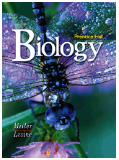BIOLOGY
by Miller & Levine
[complete Table of Contents]

|
Use the pull-down menu to jump to any of the Book's 40 Chapters: |
Additional Resources:
Be sure to visit our cloning web page, with news on clones and cloning research.
How do you feel about genetically-modified food? Page 330 discusses this important issue.
![]() Chapter 13
Chapter 13 ![]()
Genetic Engineering
In this chapter, students will read about techniques for manipulating DNA, including the production of recombinant organisms. Students will also be introduced to some of the practical applications of recombinant DNA technology. The links below lead to additional resources to help you with this chapter.
| Hot Links | |
| Take it to the Net | Teaching Links |
What are Web Codes? |
Web
Codes for Chapter 13: |
![]()
Section
13-1: Changing the Living World
![]() Humans use selective
breeding to pass desired traits on to the next generation of organisms.
Humans use selective
breeding to pass desired traits on to the next generation of organisms.
 Breeders can increase the genetic variation
in a population by inducing mutations, which are the ultimate source of
genetic variability.
Breeders can increase the genetic variation
in a population by inducing mutations, which are the ultimate source of
genetic variability.
Section
13-2: Manipulating DNA
 Scientists use their knowledge of the
structure of DNA and its chemical properties to study and change DNA molecules.
Different techniques are used to extract DNA from cells, to cut DNA into
smaller pieces, to identify the sequence of bases in a DNA molecule, and
to make unlimited copies of DNA.
Scientists use their knowledge of the
structure of DNA and its chemical properties to study and change DNA molecules.
Different techniques are used to extract DNA from cells, to cut DNA into
smaller pieces, to identify the sequence of bases in a DNA molecule, and
to make unlimited copies of DNA.
 Knowing the sequence of an organism's
DNA allows researchers to study specific genes, to compare them with the
genes of other organisms, and to try to discover the functions of different
genes and gene combinations.
Knowing the sequence of an organism's
DNA allows researchers to study specific genes, to compare them with the
genes of other organisms, and to try to discover the functions of different
genes and gene combinations.
OOPS! Early (©2002) printings of the Dragonfly Book contain a minor error in Figure 13-7. Click Here for the proper figure.
Section
13-3: Cell Transformation
 During transformation, a cell takes in
DNA from outside the cell. This external DNA becomes a part of the cell's
DNA.
During transformation, a cell takes in
DNA from outside the cell. This external DNA becomes a part of the cell's
DNA.
 If transformation is successful, the
recombinant DNA is integrated into one of the chromosomes of the cell.
If transformation is successful, the
recombinant DNA is integrated into one of the chromosomes of the cell.
Section
13-4: Applications of Genetic Engineering
 Using the basic techniques of genetic
engineering, a gene from one organism can be inserted into cells from
another organism. These transformed cells can then be used to grow new
organisms.
Using the basic techniques of genetic
engineering, a gene from one organism can be inserted into cells from
another organism. These transformed cells can then be used to grow new
organisms.